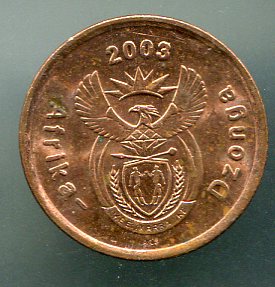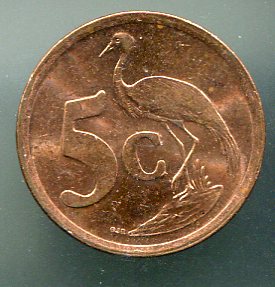One of my small-change-of-the-world coins has words in the Khoisan language on it. That, I’ve discovered, is a modern umbrella term for the peoples once known as the Bushmen and the Hottentots, and their languages. The words on the coin are rendered ǃKE E: ǀXARRA ǁKE, but don’t ask me how that’s pronounced. The English translation is, “diverse people unite.”
That’s the motto found on the South African coat of arms, which happens to be on the observe of the 2003 South African 5-cent piece that I have. A lot of recent SA coinage features the coat of arms, which was adopted by the post-Apartheid government in 2000.
The coat of arms also includes ears of wheat, elephant tusks, a shield, two human figures, a spear and a knobkierie. Over all that is a secretary bird and a rising sun. Around the coat of arms is Africa-Dzonga, which is “South Africa” in Tsonga, one of the 11 official languages of the country.
 Apparently the languages take turns each year on the coinage, beginning in 2002. Tsonga’s turn happened to come the next year, at least on the 5-cent pieces (it seems to be different on other denominations).
Apparently the languages take turns each year on the coinage, beginning in 2002. Tsonga’s turn happened to come the next year, at least on the 5-cent pieces (it seems to be different on other denominations).
The reverse of the coin is simpler: a blue crane and the value.
 Minting of the copper-plated steel 5-cent piece stopped in 2012, a victim of inflation, but the coins weren’t demonetized, so it’s still technically worth about three-tenths of US cent. The 1- and 2-cent pieces were discontinued ten years earlier.
Minting of the copper-plated steel 5-cent piece stopped in 2012, a victim of inflation, but the coins weren’t demonetized, so it’s still technically worth about three-tenths of US cent. The 1- and 2-cent pieces were discontinued ten years earlier.